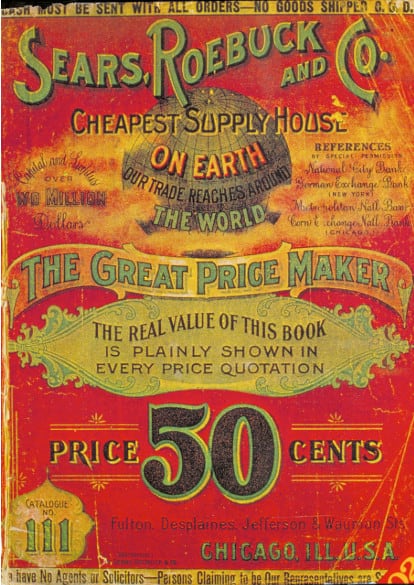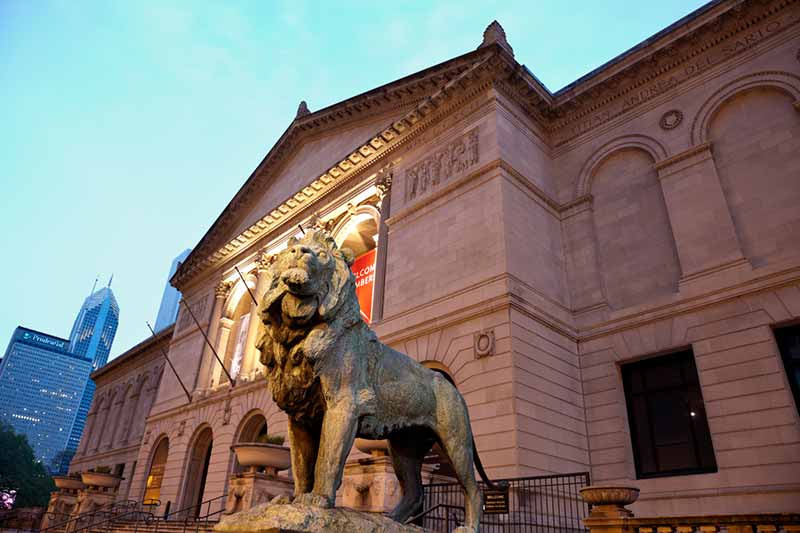
Often under-appreciated, but always there, is design. Design is the intent behind the look of a building, the style of a sign or a poster, and the choice to make an accent color red instead of blue. Be it architecture, a painting, or a sculpture, design is everywhere, and good design stands out from the rest. There’s no better example of this than in the city of Chicago.
As one of the most diverse cities in the world, Chicago is home to every type of design imaginable. The storied city has produced hundreds of designers whose work has been showcased all over the world. And with the rise of the brand, Chicago has shown great competence in graphic design as well.
The Rise of Design in Chicago
In 1896, Sears, Roebuck and Company, more commonly known as the Sears department store, published a catalog of over 500 items. Founded in Chicago, this was the company’s first time charging for such a service. This means it had to appeal to as wide a demographic as possible. Bicycles, watches, books, clothes — an enormous number of products were to be included without overwhelming a potential customer. Not only this, but testimonials, tag-lines, slogans and more must cleverly fit-in without overlaying the products.
Of course, the company successfully achieved this and the Sears catalog became a household necessity throughout the entire country. But doing so was no accident. It was the result of graphic designers creating this catalog with intent. Understanding where an image should go in the place of text. Discovering the natural way one’s eyes will move along the catalog, and aligning the content to serve that.

Sears, Roebuck and Co. catalog’s cover design
It is from here that organizations such as The Society of Typographic Arts were founded. Even Playboy Magazine was headquartered here from 1959 until 2012. But most notable of all is the city’s Art Institute and the Institute of Design.
Chicago’s Art Institute was opened in 1893. Many will recognize it from the giant bronze lions out front, existing next to the world-famous Millennium Park. Of course, the building has expanded over the years, eventually covering World War I, World War II, art from Asia and Europe, and even a film center.
In particular, the current Art Institute holds a collection of one Chicago-based graphic designer, James Teague. Teague actually studied industrial design at the Art Institute’s school before opening up his own firm in 1950 alongside two partners. These documents date anywhere from 1950 to around 1990.
Otherwise, the Art Institute holds many events and showcases of regarding graphic design. Currently, it’s hosting a Bauhaus Chicago: Design in the City event. Bauhaus, a German school with a distinct design process, was eventually adopted by some designers in Chicago. This showcase exemplifies that.

The Art Institute of Chicago
As for the Institute of Design, the school was founded as The New Bauhaus back in 1937 by László Moholy-Nagy, a longtime Bauhaus expert. One year later, a longtime director of the German Bauhaus had come, Ludwig Mies van der Rohe, and became the head of architecture at the Illinois Institute of Technology. Van der Rohe brought some extra clout to the Institute which they considered “the ideal ground on which to work out an educational principle which strives for the closest connection between art, science, and technology.”
With Chicago being one of the main cities involved in the Industrial Revolution, the Bauhaus aligned its mission alongside it. Their goal? To modernize everything from schools to architecture, utilizing the latest technology to build that era’s equivalent of contemporary style.
Now, this Institute leads projects related to current events. One recent project is working to alter the future of design in Chicago neighborhood Bronzeville. Back in the 1930s, the Institute had bought out a lot of the area’s cultural landmarks, pushing relevant artists out of the space. The current owners are working to reform that relationship, leading community design projects and empowering citizens to start their own projects.
While Chicago certainly grew in stature thanks to its approach to art and graphic design, it’s especially known today for its advertising scene. Holding host to some of the best agencies in the world, the city’s first big one was Coburn, Cook & Company, founded in 1865.
The agency was founded by Carlos Allen Cook. Back then, ads were little more than personalized posters different companies would purchase. However, Mr. Cook’s ideas weren’t enough. Through multiple partners, the agency ended up owing a ton of money to debtors that they simply couldn’t pay back. Mr. Cook gave up on advertising after this.
Shortly afterward was the founding of the much more successful Leo Burnett Company. Burnett founded the agency in 1935, during the middle of the Great Depression. The man mortgaged his house to do so, but considering the company was billing over $100 million a year by 1960, it certainly paid off. Mr. Burnett had quite the career beforehand, however, which lead to his company’s great success.
Originally a police reporter, Burnett was fascinated by the growing world of automobiles. He ended up leaving his first profession to join the Cadillac Clearing House publication. It was here that he’d travel to different auto shows around the country, covering the different forms of advertising held by companies at each one. After a brief stint in the Navy, he became a head of advertising at Cadillac before moving to work with Homer McKee Advertising Agency.
Armed with this knowledge he’d learned at previous groups, Burnett made the move to his own firm in 1935. At this time, Chicago was stepping up its design game but wasn’t incredibly known for its advertising. Fortunately, Burnett made the two go hand in hand.
Without overdoing it, Burnett’s design was focused on the simplicity of a product. He let the design showcase the product first, rather than overtake it. It had a very midwestern, homey feel rather than the in-your-face experience of spaces like New York – an advertising hotspot at the time. “Don’t tell me how good you make it. Tell me how good it makes me when I use it” was a popular motto by Burnett.
It’s because of this approach that more cozy brands like Pillsbury and Campbells Soup became clients. Eventually, the agency went on to create greats like Tony the Tiger, Toucan Sam, and the Marlboro Man. Some of these ads could be considered outdated today, as they appealed to the masculine American vision at the time. However, the agency often adapts to the times and has since released more contemporary advertisements.
While Leo Burnett is one of the most notable advertising agencies in the city, smaller groups had pushed the city forward as well. For instance, in 1903, designers Fred and Bertha Goudy founded the Village Press – Fred starting a typography career at 40. It was here they hired one Oswald Cooper who had gone on to be a notable type designer. Cooper was one of the reasons big, bold letters were all over World War 1 propaganda.
Diversity in Graphic Design
With the rise of the internet, Chicago’s presence in the graphic design community has only grown. In fact, whereas beforehand it was mainly full of white men and women, the last twenty years especially have seen an upsurge in African American graphic designers, while prevalent designers from the past are finally getting recognized.
One African American designer, Charles Dawson, began working in graphic design in the 1920s in Bronzeville. However, he was never hired by white clients. Instead, he created designs for black-owned businesses and publications. He designed with the intent to uplift the black community through his art. Following him were designers like Mentrell Parker or Vernon Guider, the latter of which is still creating signs and logos for churches and restaurants on the Southside.
Another designer who followed Dawson even worked a job for a white business, Gene Windslow, though he was asked to remain hidden despite his “excellent” designs. He eventually returned to the black community instead. Fortunately, black people are much more prevalent in today’s scene, with designers like Elise Swopes and Brandon Breaux taking the scene by storm.
Swopes fascinatingly only does work on her phone, creating advertisements and building surrealist environments with just the applications on her mobile device. “While almost everyone has a phone, not everyone makes art with it,” her website reads. Even crazier, she’s entirely self-taught, and built her business completely on Instagram.
Breaux, on the other hand, works with oil paint and digital illustration software to create designs with a focus on the psyche. He’s created websites, logos, magazines, and even Chance the Rapper’s most famous album covers.
While Swopes was self-taught, Breaux and many emerging artists cut their teeth at DePaul University, one of Chicago’s many art-focused schools. The University of Illinois at Chicago, Columbia, DePaul, Robert Morris University, and many more have served designers, each working to find their voice before implementing it across the city.
Nowadays, Chicago is also home to a variety of graphic design firms and large globally recognized advertising agencies that create the many billboards, signs, and commercial art seen throughout the city.
